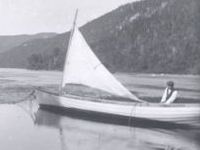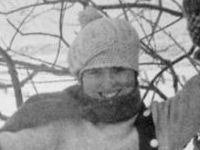![]()
 It's the early 1900s and two women stand on a flat rocky beach on the Humber River, wearing long flowing skirts, each one holding a fishing rod. The water is calm. A male companion sits nearby in an anchored sailboat and two white tents are pitched down the beach a few yards. Their purpose is as clear as the waters they fish: they are at play.
It's the early 1900s and two women stand on a flat rocky beach on the Humber River, wearing long flowing skirts, each one holding a fishing rod. The water is calm. A male companion sits nearby in an anchored sailboat and two white tents are pitched down the beach a few yards. Their purpose is as clear as the waters they fish: they are at play.
It is easy to overlook recreation and sport when turning our attention to the past, mostly because it seems that attending to business, child rearing, physical and domestic labour would leave few spare hours to throw a ball, frolic in the water or engage in a team sport.
This was, of course, not the case.
Braving the cool temperatures of the North Atlantic or the many fresh water ponds on the island, swimming was a popular summer pastime. Some women waded leisurely into the ocean wearing full skirts, while the more competitive swimmers wore bathing costumes complete with goggles for the experience.
 Winter was also a time for escape. There is no better illustration of this than Miss Lizzie Barbour, proudly displaying her ice–fishing catch and yet dressed for high tea in a plumaged hat and high collared jacket. Surely these are not the accoutrements of labour.
Winter was also a time for escape. There is no better illustration of this than Miss Lizzie Barbour, proudly displaying her ice–fishing catch and yet dressed for high tea in a plumaged hat and high collared jacket. Surely these are not the accoutrements of labour.
Women's organized sports like softball, basketball and hockey became popular in the early 20th century and female-only teams and leagues began to take shape. The Women's Patriotic Association turned to women's hockey as a means of fundraising for the war effort, hosting a tournament in 1916.
Like today, music played a prominent recreational role in the culture of pre–Confederation Newfoundland and Labrador. Women across the province took part in kitchen sessions and formal concerts. They sang choral music in groups and sang ballads alone. Many women played guitar, fiddle, and accordion among other instruments. Some learned when they were just little girls. May Hussey from Spaniard's Bay bought her first accordion when she was ten years old and she taught herself to play. You can read May's biography or listen to her tell the story of her first accordion and play the instrument.
 Women skated, snow–shoed, boated and swam. They joined teams, fished, sang songs and played musical instruments. There were picnics in summer and card games in winter, but occasionally there were also stolen moments of solitude, rest and redemption–like a summer afternoon spent napping in a hammock. At rest in 1940, "Ches Carter's Mother" in Greenspond is stretched into a gentle curve in a backyard hammock, perhaps unwinding at the end of a work week, or taking an hour to recover before stepping back into her busy life.
Women skated, snow–shoed, boated and swam. They joined teams, fished, sang songs and played musical instruments. There were picnics in summer and card games in winter, but occasionally there were also stolen moments of solitude, rest and redemption–like a summer afternoon spent napping in a hammock. At rest in 1940, "Ches Carter's Mother" in Greenspond is stretched into a gentle curve in a backyard hammock, perhaps unwinding at the end of a work week, or taking an hour to recover before stepping back into her busy life.
For more information on Women in Sport & Recreation, visit The Rooms virtual exhibit Women in Sport: Pre-Confederation Newfoundland.

